Analysis of the principles of SpringBoot exception handling
Exception handling process
Execute the target method. Any exception during the running of the target method will be caught by catch and mark the end of the current request. dispatchException throws an exception
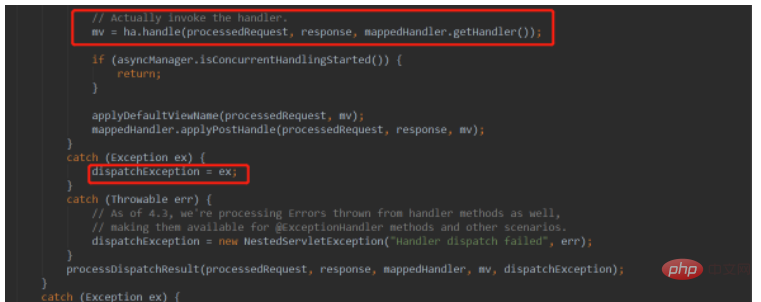
Enter the view parsing process and render the page. When an exception occurs, the parameter mv is empty and the captured exception dispatchException## is passed in.
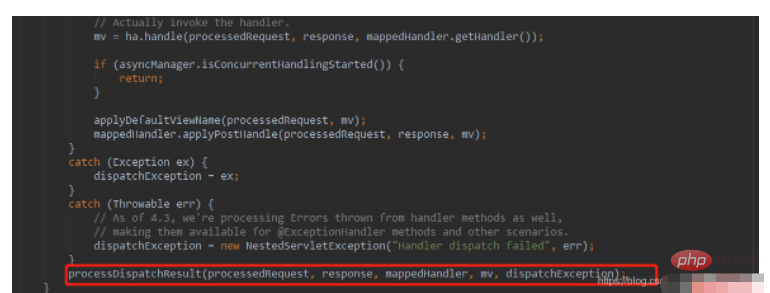
handler, and return ModelAndView
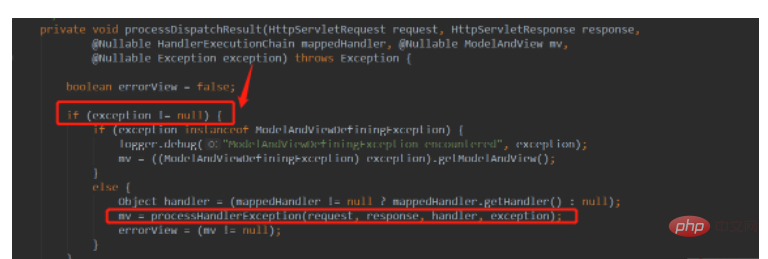
HandlerExceptionResolvers and find the parser that can handle the current exception to resolve the exception

resolveExceptionResolve the exception, pass in the request and response objects, which method, the exception occurred, and then customize the exception handling to return ModelAndView

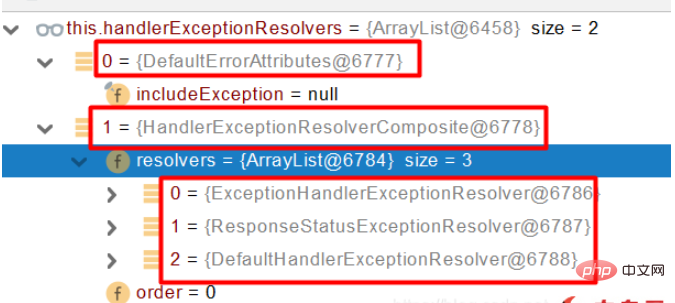
DefaultErrorAttributesFirst handle the exception and The information is saved to the request field and returned null
 ##②
##②
is used to process annotations@ExceptionHandlerAnnotated method exception③
Used to handle method exceptions annotated with @ResponseStatus④
Default processor exception parser, handles some common exceptions (4) If no parser can handle the exception, the exception will be thrown
 (5) If no parser can handle the current exception, a
(5) If no parser can handle the current exception, a
request will eventually be sent to forward the saved exception information to /error. BasicErrorController is specially used to handle /error requests. BasicErrorController will traverse all ErrorViewResolver to parse error views. If there is no custom error view parsing The default DefaultErrorViewResolver will be used, and the response code will be used as the address of the error page. The template engine will eventually respond to this page. Several exception handling methods and principles
1. Customize the error page,
error/404.html, error/5xx.html. If there is an accurate error status code page, it will be matched accurately. If there is no page, look for 4xx.html. If there is no page, it will trigger a white page. 2. Use
and @ExceptionHandler handles global exceptions, the bottom layer is supported by ExceptionHandlerExceptionResolver
##3. Use  @ResponseStatus
@ResponseStatus
ResponseStatusExceptionResolver. The bottom layer calls response.sendError(statusCode, resolvedReason), and Tomcat will receive an error. At the end of the request, an empty ModelAndView is returned, so that no processing parser can handle the current exception, and the /error request will eventually be sent, BasicErrorController is specially used to handle /error requests and adapt to 4xx.html or 5xx.html pages
DefaultHandlerExceptionResolver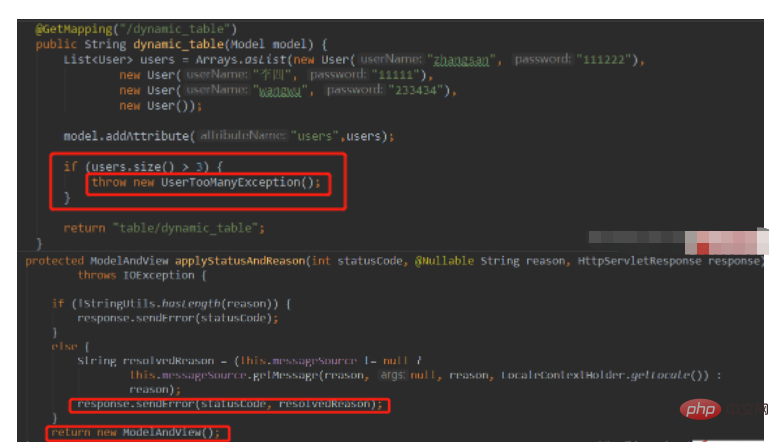 that handles exceptions at the bottom of the framework. The bottom layer is also
that handles exceptions at the bottom of the framework. The bottom layer is also
response.sendError(HttpServletResponse.SC_NOT_ACCEPTABLE)
error. At the end of the request, an empty ModelAndView is returned, so that no processing parser can handle the current exception, and the /error request will eventually be sent, BasicErrorController is specially used to handle /error requests, adapting to 4xx.html or 5xx.html page
protected ModelAndView doResolveException(
HttpServletRequest request, HttpServletResponse response, @Nullable Object handler, Exception ex) {
try {
if (ex instanceof HttpRequestMethodNotSupportedException) {
return handleHttpRequestMethodNotSupported(
(HttpRequestMethodNotSupportedException) ex, request, response, handler);
}
else if (ex instanceof HttpMediaTypeNotSupportedException) {
return handleHttpMediaTypeNotSupported(
(HttpMediaTypeNotSupportedException) ex, request, response, handler);
}
else if (ex instanceof HttpMediaTypeNotAcceptableException) {
return handleHttpMediaTypeNotAcceptable(
(HttpMediaTypeNotAcceptableException) ex, request, response, handler);
}
else if (ex instanceof MissingPathVariableException) {
return handleMissingPathVariable(
(MissingPathVariableException) ex, request, response, handler);
}
else if (ex instanceof MissingServletRequestParameterException) {
return handleMissingServletRequestParameter(
(MissingServletRequestParameterException) ex, request, response, handler);
}
else if (ex instanceof ServletRequestBindingException) {
return handleServletRequestBindingException(
(ServletRequestBindingException) ex, request, response, handler);
}
else if (ex instanceof ConversionNotSupportedException) {
return handleConversionNotSupported(
(ConversionNotSupportedException) ex, request, response, handler);
}
else if (ex instanceof TypeMismatchException) {
return handleTypeMismatch(
(TypeMismatchException) ex, request, response, handler);
}
else if (ex instanceof HttpMessageNotReadableException) {
return handleHttpMessageNotReadable(
(HttpMessageNotReadableException) ex, request, response, handler);
}
else if (ex instanceof HttpMessageNotWritableException) {
return handleHttpMessageNotWritable(
(HttpMessageNotWritableException) ex, request, response, handler);
}
else if (ex instanceof MethodArgumentNotValidException) {
return handleMethodArgumentNotValidException(
(MethodArgumentNotValidException) ex, request, response, handler);
}
else if (ex instanceof MissingServletRequestPartException) {
return handleMissingServletRequestPartException(
(MissingServletRequestPartException) ex, request, response, handler);
}
else if (ex instanceof BindException) {
return handleBindException((BindException) ex, request, response, handler);
}
else if (ex instanceof NoHandlerFoundException) {
return handleNoHandlerFoundException(
(NoHandlerFoundException) ex, request, response, handler);
}
else if (ex instanceof AsyncRequestTimeoutException) {
return handleAsyncRequestTimeoutException(
(AsyncRequestTimeoutException) ex, request, response, handler);
}
}
catch (Exception handlerEx) {
if (logger.isWarnEnabled()) {
logger.warn("Failure while trying to resolve exception [" + ex.getClass().getName() + "]", handlerEx);
}
}
return null;
}5. Custom implementation HandlerExceptionResolver handles exceptions and can be used as the default global exception handling rule
@Order(value = Ordered.HIGHEST_PRECEDENCE)
@Component
public class CustomerHandlerExceptionResolver implements HandlerExceptionResolver {
@Override
public ModelAndView resolveException(HttpServletRequest request, HttpServletResponse response, Object handler, Exception ex) {
try {
response.sendError(521,"I love you !");
} catch (IOException e) {
e.printStackTrace();
}
return new ModelAndView();
}
}
ErrorViewResolver Implement custom exception handling.
(1) When the bottom layer calls response.sendError, the error request will be forwarded to basicErrorController by default, BasicErrorController Specially used to handle /error requests, adapting 4xx.html or 5xx.html pages
(2) If there is no parser for the exception It can be handled, and the bottom layer of tomcat will also call response.sendError. errorThe request will be forwarded to basicErrorController by default, BasicErrorController is specially used to handle /error requests, adapting 4xx.html or 5xx.html page.
(3)basicErrorController The page address you want to go to is determined by the ErrorViewResolver error view resolver, that is, adaptation 4xx.html Or 5xx.html page.
The above is the detailed content of Analysis of the principles of SpringBoot exception handling. For more information, please follow other related articles on the PHP Chinese website!

Hot AI Tools

Undresser.AI Undress
AI-powered app for creating realistic nude photos

AI Clothes Remover
Online AI tool for removing clothes from photos.

Undress AI Tool
Undress images for free

Clothoff.io
AI clothes remover

AI Hentai Generator
Generate AI Hentai for free.

Hot Article

Hot Tools

Notepad++7.3.1
Easy-to-use and free code editor

SublimeText3 Chinese version
Chinese version, very easy to use

Zend Studio 13.0.1
Powerful PHP integrated development environment

Dreamweaver CS6
Visual web development tools

SublimeText3 Mac version
God-level code editing software (SublimeText3)

Hot Topics
 How Springboot integrates Jasypt to implement configuration file encryption
Jun 01, 2023 am 08:55 AM
How Springboot integrates Jasypt to implement configuration file encryption
Jun 01, 2023 am 08:55 AM
Introduction to Jasypt Jasypt is a java library that allows a developer to add basic encryption functionality to his/her project with minimal effort and does not require a deep understanding of how encryption works. High security for one-way and two-way encryption. , standards-based encryption technology. Encrypt passwords, text, numbers, binaries... Suitable for integration into Spring-based applications, open API, for use with any JCE provider... Add the following dependency: com.github.ulisesbocchiojasypt-spring-boot-starter2. 1.1Jasypt benefits protect our system security. Even if the code is leaked, the data source can be guaranteed.
 How to use Redis to implement distributed locks in SpringBoot
Jun 03, 2023 am 08:16 AM
How to use Redis to implement distributed locks in SpringBoot
Jun 03, 2023 am 08:16 AM
1. Redis implements distributed lock principle and why distributed locks are needed. Before talking about distributed locks, it is necessary to explain why distributed locks are needed. The opposite of distributed locks is stand-alone locks. When we write multi-threaded programs, we avoid data problems caused by operating a shared variable at the same time. We usually use a lock to mutually exclude the shared variables to ensure the correctness of the shared variables. Its scope of use is in the same process. If there are multiple processes that need to operate a shared resource at the same time, how can they be mutually exclusive? Today's business applications are usually microservice architecture, which also means that one application will deploy multiple processes. If multiple processes need to modify the same row of records in MySQL, in order to avoid dirty data caused by out-of-order operations, distribution needs to be introduced at this time. The style is locked. Want to achieve points
 How SpringBoot integrates Redisson to implement delay queue
May 30, 2023 pm 02:40 PM
How SpringBoot integrates Redisson to implement delay queue
May 30, 2023 pm 02:40 PM
Usage scenario 1. The order was placed successfully but the payment was not made within 30 minutes. The payment timed out and the order was automatically canceled. 2. The order was signed and no evaluation was conducted for 7 days after signing. If the order times out and is not evaluated, the system defaults to a positive rating. 3. The order is placed successfully. If the merchant does not receive the order for 5 minutes, the order is cancelled. 4. The delivery times out, and push SMS reminder... For scenarios with long delays and low real-time performance, we can Use task scheduling to perform regular polling processing. For example: xxl-job Today we will pick
 How to solve the problem that springboot cannot access the file after reading it into a jar package
Jun 03, 2023 pm 04:38 PM
How to solve the problem that springboot cannot access the file after reading it into a jar package
Jun 03, 2023 pm 04:38 PM
Springboot reads the file, but cannot access the latest development after packaging it into a jar package. There is a situation where springboot cannot read the file after packaging it into a jar package. The reason is that after packaging, the virtual path of the file is invalid and can only be accessed through the stream. Read. The file is under resources publicvoidtest(){Listnames=newArrayList();InputStreamReaderread=null;try{ClassPathResourceresource=newClassPathResource("name.txt");Input
 Comparison and difference analysis between SpringBoot and SpringMVC
Dec 29, 2023 am 11:02 AM
Comparison and difference analysis between SpringBoot and SpringMVC
Dec 29, 2023 am 11:02 AM
SpringBoot and SpringMVC are both commonly used frameworks in Java development, but there are some obvious differences between them. This article will explore the features and uses of these two frameworks and compare their differences. First, let's learn about SpringBoot. SpringBoot was developed by the Pivotal team to simplify the creation and deployment of applications based on the Spring framework. It provides a fast, lightweight way to build stand-alone, executable
 How SpringBoot customizes Redis to implement cache serialization
Jun 03, 2023 am 11:32 AM
How SpringBoot customizes Redis to implement cache serialization
Jun 03, 2023 am 11:32 AM
1. Customize RedisTemplate1.1, RedisAPI default serialization mechanism. The API-based Redis cache implementation uses the RedisTemplate template for data caching operations. Here, open the RedisTemplate class and view the source code information of the class. publicclassRedisTemplateextendsRedisAccessorimplementsRedisOperations, BeanClassLoaderAware{//Declare key, Various serialization methods of value, the initial value is empty @NullableprivateRedisSe
 How to implement Springboot+Mybatis-plus without using SQL statements to add multiple tables
Jun 02, 2023 am 11:07 AM
How to implement Springboot+Mybatis-plus without using SQL statements to add multiple tables
Jun 02, 2023 am 11:07 AM
When Springboot+Mybatis-plus does not use SQL statements to perform multi-table adding operations, the problems I encountered are decomposed by simulating thinking in the test environment: Create a BrandDTO object with parameters to simulate passing parameters to the background. We all know that it is extremely difficult to perform multi-table operations in Mybatis-plus. If you do not use tools such as Mybatis-plus-join, you can only configure the corresponding Mapper.xml file and configure The smelly and long ResultMap, and then write the corresponding sql statement. Although this method seems cumbersome, it is highly flexible and allows us to
 How to get the value in application.yml in springboot
Jun 03, 2023 pm 06:43 PM
How to get the value in application.yml in springboot
Jun 03, 2023 pm 06:43 PM
In projects, some configuration information is often needed. This information may have different configurations in the test environment and the production environment, and may need to be modified later based on actual business conditions. We cannot hard-code these configurations in the code. It is best to write them in the configuration file. For example, you can write this information in the application.yml file. So, how to get or use this address in the code? There are 2 methods. Method 1: We can get the value corresponding to the key in the configuration file (application.yml) through the ${key} annotated with @Value. This method is suitable for situations where there are relatively few microservices. Method 2: In actual projects, When business is complicated, logic






